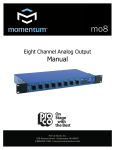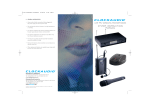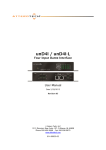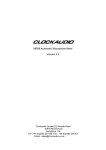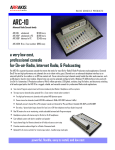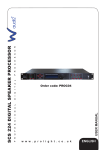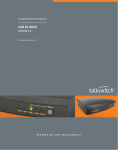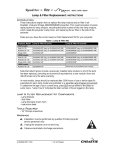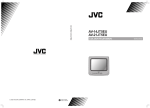Download CDT 100 User Manual
Transcript
CDT100 User Manual CDT100 Clockaudio Dante Transporter Four analog and control inputs to Dante enabled endpoint User Manual Clockaudio Ltd. Address: 22 Arnside Road, Waterlooville, Hampshire, PO7 7UP Tel: +44(0)23 9225-1193 Fax: +44(0)23 9225 1201 Email: [email protected] Clockaudio North America Inc. Address: 2891, du Meunier, Unit 103, Vaudreuil-Dorion, QC, Canada J7V 8P9 Toll Free: 1-888-424-9797 Tel: 888-424-9797 Fax: 450-424-3660 Email: www.clockaudio.com Clockaudio PTE Ltd. Address: BizTech Centre, Unit # 01-02, 627A Aljunied Road, Singapore, 389842 Tel: +65 67484738 Fax: +65 67484428 Email: [email protected] © Clockaudio 2015 CDT100 User Manual IMPORTANT SAFETY INSTRUCTIONS The symbols below are internationally accepted symbols that warn of potential hazards with electrical products. This symbol, wherever it appears, alerts you to the presence of un-insulated dangerous voltage inside the enclosure voltage that may be sufficient to constitute a risk of shock. This symbol, wherever it appears, alerts you to important operating and maintenance instructions in the accompanying literature. Please read the manual 1. Read these instructions. 2. Keep these instructions. 3. Heed all warnings. 4. Follow all instructions. 5. Do not use this apparatus near water. 6. Clean only with a dry cloth. 7. Do not block any ventilation openings. Install in accordance with the manufacturer's instructions. 8. Do not install near any heat sources such as radiators, heat registers, stoves, or other apparatus (including amplifiers) that produce heat. 9. Do not defeat the safety purpose of the polarized or grounding-type plug. A polarized plug has two blades with one wider than the other. A grounding type plug has two blades and third grounding prong. The wider blade or the third prong is provided for your safety. If the provided plug does not fit into your outlet, consult an electrician for replacement of the obsolete outlet. 10. Protect the power cord from being walked on or pinched particularly at plugs, convenience receptacles, and the point where they exit from the apparatus. 11. Only use attachments/accessories as specified by Clockaudio. 12. Use only with the bracket specified by the manufacturer. 13. Refer all servicing to qualified service personnel. Servicing is required when the apparatus has been damaged in any way, such as power-supply cord or plug is damaged, liquid has been spilled or objects have fallen into the apparatus, if the apparatus has been exposed to rain or moisture, does not operate normally or has been dropped. 14. This apparatus shall be connected to a mains socket outlet with a protective earthing connection. 15. If rack mounting, provide adequate ventilation. Equipment may be located above or below this apparatus but some equipment (like large power amplifiers) may cause an unacceptable amount of hum may generate too much heat and degrade the performance of this apparatus. TO REDUCE THE RISK OF FIRE OR ELECTRIC SHOCK, DO NOT EXPOSE THIS APPARATUS TO RAIN OR MOISTURE. © Clockaudio 2015 2 CDT100 User Manual LIMITED ONE YEAR WARRANTY The equipment is warranted for one year from date of purchase from Clockaudio against defects in materials or workmanship. This warranty does not cover equipment which has been abused or damaged by careless handling or shipping. This warranty does not apply to used or demonstrator equipment. Should any defect develop, Clockaudio will, at our option, repair or replace any defective parts without charge for either parts or labor. If Clockaudio cannot correct the defect in the equipment, it will be replaced at no charge with a new item. Clockaudio will pay for the cost of returning the replacement equipment to you. This warranty applies only to items returned to Clockaudio, shipping costs prepaid, within one year from the date of purchase. Note: This equipment has been tested and found to comply with the limits for a Class A digital device, pursuant to Part 15 of the FCC Rules and EN55022. These limits are designed to provide reasonable protection against harmful interference when the equipment is operated in a commercial environment. This equipment generates, uses, and can radiate radio frequency energy and, if not installed and used in accordance with the instruction manual, may cause harmful interference to radio communications. Operation of this equipment in a residential area is likely to cause harmful interference, in which case the user will be required to correct the interference at his own expense. © Clockaudio 2015 3 CDT100 User Manual Contents 1 – OVERVIEW .................................................................................................................................................................................................... 5 2 – DEVICE FEATURES ...................................................................................................................................................................................... 6 3 – CONNECTIONS ............................................................................................................................................................................................. 7 3.1 – Input from a Balanced Source.. ........................................................................................................................7 3.2 – Input from an Unbalanced Source ...................................................................................................................7 4 – DEVICE CONFIGURATION ........................................................................................................................................8 4.1 – IP Address Setup .............................................................................................................................................8 4.2 – Device Identification ........................................................................................................................................9 5 – DANTE DAISY CHAINING .................................................................................................................................10 5.1 – Daisy Chain Illustration - Example 1 ...............................................................................................................11 5.2 – Daisy Chain Illustration - Example 2 ...............................................................................................................12 6 – MOUNTING.....................................................................................................................................................13 7 – CONTROL MODULES .......................................................................................................................................14 7.1 – Crestron .........................................................................................................................................................15 7.2 – AMX ................................................................................................................................................................16 4 – ARCHITECT SPECIFICATIONS ...........................................................................................................................17 © Clockaudio 2015 4 CDT100 User Manual 1 - Overview The CDT 100 four input Dante interface is the ideal interface for adding mic inputs to a Dante system. The small form factor to the CDT 100 allows them to be mounted almost anywhere, putting them close to the microphone sources and minimizing interference-prone analog wiring. Figure 1 - CDT100 front and back panel CDT 100 Features: Easy to install with under table mounting. Audio and control signals transported over Dante. 4 X mic/line inputs using 3-pin de-pluggable connectors for “Balanced” or “Unbalanced” connectivity. Provides phantom power for each input also supports a +48V phantom power option. Powered by an external +12VDC (ordered separately). Power can also be daisy chained The CDT 100 has 4 X connections to support the CH32 button and other Clockaudio control devices: CRM 202S CS S Series S 80S SM 80S TS001 The CDT 100 connects directly to ARM-C port for the ARM motorized microphone. The CDT 100 has two network connections to allow Dante Daisy Chaining (DDC). DDC further simplifies system infrastructure wiring by allowing multiple CDT100’s to use a single CAT 5 home run connection to a network switch. Compatible with any Dante capable audio DSP. The CDT 100 can be controlled and monitored with 3rd party control software using direct UDP messages. © Clockaudio 2015 5 CDT100 User Manual 2 – Device Features Figure 2 - CDT100 front panel Figure 3 - CDT100 back panel Power LED. Reset Button (recessed not visible). Address Select. 4 Balanced audio inputs with phantom power, multiple units may be daisy chained. 4 X CH32 control inputs. Connects directly to CH32 Litetouch and other Clockaudio control devices. ARM-C controller direct connection. 2 X Dante Ethernet interface connector and indicators. Daisy chain power input and output. Power Socket - Use with optional 12V DC supply only. © Cockaudio 2015 6 CDT100 User Manual 3 – Connections The CDT 100 accepts unbalanced or balanced audio devices. Refer to the following diagrams and instructions for connecting different types of audio devices. Professional grade audio cabling is recommended to achieve the best audio performance throughout the system. 3.1 - Input from a Balanced Source To connect balanced sources to the CDT 100: Connect positive output to positive input, negative output to negative input Connect the grounds together through the cable shield. CDT 100 unDIO2x2 Input + - Source + Shield Figure 4 - Balanced Source Connection 3.2 – Input from an Unbalanced Source To connect a 2-wire unbalanced source to the CDT 100: Connect the positive output of the unbalanced source to the positive input of the CDT 100. Connect both the source and CDT 100 input grounds together Short the negative input of the CDT 100 to ground at the input of the CDT 100. CDT 100 unDIO2x2 Input + - Source + Shield Figure 5 - 2-Wire Unbalanced Source Connection To connect a 3-wire unbalanced source to a CDT100: Short the negative conductor to the shield at the source connection. CDT 100 unDIO2x2 Input + - Source + Shield Figure 6 - 3-Wire Unbalanced Source Connection © Clockaudio 2015 7 CDT100 User Manual 4 – Device Configuration There are two parts of the device that require software to setup: 1. The audio routing. 2. The configurable features of the device itself. The audio routing should be carried out using Audinate’s Dante Controller, available for Windows and Mac OS X from the Audinate website www.audinate.com along with instructions on how to use the software and setting up routes on a Dante network. Dante Controller is a free software application that enables you to route audio and configure devices on a Dante network. With automatic device discovery, one-click signal routing and user-editable device and channel labels. See the overview link for more details on Dante audio networking. Features: View all Dante-enabled audio devices and their channels on the network.. View and edit device clock and network settings Route audio between devices, and view the state of existing audio routes Rename devices and channels using your own friendly names Customize the receive latency (latency before playout) Save and reapply audio routing presets Edit presets offline, and apply as configurations for new network deployments Change sample rates and clock settings View multicast bandwidth across the network View transmit and receive bandwidth for each device View device performance information, including latency stats, clock stability stats and packet errors View comprehensive, configurable event logs 4.1 - IP Address Setup Important Notes: When using Dante controller, the CDT100 will be shown using a default device name of CDT100-###### where ‘######’ is the last six characters of the devices MAC address. Failure to correctly configure IP addresses will not allow an CDT100 device to correctly authenticate in the software and while it will show up in Dante Controller. The input and output channels won’t be visible and routing of audio to and from the CDT100 will not be possible. In order to configure an CDT100 both to set up its internal parameters and also setup audio routing, the PC will need to be able to communicate with it over the network. While all Dante devices will be discovered regardless of the IP address setup on the PC, communication can only occur if the PC and the device have compatible IP addresses. By default, CDT100 is set to get a dynamic IP address. As with all Dante devices, if the CDT100 device does not find a DHCP server to retrieve an IP address from, it will give itself an automatic private IP address (APIPA) instead. An APIPA is always in the range 169.254.x.y. To ensure communication, the PC can either be set to get a dynamic IP address, or be given a static IP address in the range 169.254.x.y. The PC may require a restart for the changes to take affect. Further information on IP setup for an audio system using Dante can be found in the FAQ’s on the Audinate website (https://www.audinate.com/resources/faqs). © Clockaudio 2015 8 CDT100 User Manual 4.2 – Device Identification The device identification feature allows the user to see which device is physically being configured. When the identify feature is active, the power LED on the active device will flash. The Identify check box shows the state of the device identify feature. If the box is checked, the feature is active on the active unit. If the check box is clear, the identify feature is inactive. To change the state of the feature, simply click in the Identify check box to toggle its state from off to on or on to off. The identify function will continue to operate until the function is turned off via the user interface or the device is powered down. © Clockaudio 2015 9 CDT100 User Manual 5 – Dante Daisy Chaining Overview: A unique feature of the CDT100 is its ability to allow daisy chaining of devices. This allows CDT100 units in close proximity to one another to utilize a single home run of Ethernet cable back to the switch thus saving on installation costs. Daisy chaining simply requires the new device be connected to the spare Ethernet port of the last CDT100 device in the current chain. Not only can the Ethernet connection be daisy chained, power can also be daisy chained too by connecting the daisy chain power output on the last active device to the daisy chain power input on the new device. The number of devices that can be daisy chained is limited. The maximum that can ever be daisy chained is 6 devices in a single chain. Beyond that the number of switch hops may cause audio problems due to excessive latency and increased clock jitter. The other limitation is the power supply, if power is also being daisy chained from device to device. Standalone: If power is supplied to the first device via a standalone supply, the supplies maximum power output determines the number of devices it can support (assume 4W @ 12V DC per device). To daisy chain a device to another CDT100: Connect an Ethernet cable from the data only port of the CDT100 to one of the ports of the CDT 100 to be chained to supply the network information. To chain the power, connect the “Link out” connector to the “Link in” connector on the CDT100 to be chained. A third unit could be chained by connecting it in the same way to the second unit and so on. Network Configuration Note: If the CDT100 units are installed in a networked daisy-chain topology, it is highly recommended to only configure unicast flows from each of the CDT100 devices' Dante transmitters. The addition of multicast flows along the daisy chain can overwhelm the switches in the chain with unnecessary multicast audio traffic resulting in potential latency and network clock synchronization issues, especially on the units installed at the end of the daisy-chain network segment. Additionally, if there are a significant number of multicast audio flows configured on the Dante network, it is recommended that the core network switches that interface to the daisy-chained CDT100 network segments be configured with the appropriate IGMP settings to shield the CDT100 chain from unnecessary multi-cast audio traffic. © Clockaudio 2015 10 CDT100 User Manual 5.1 – Dante Daisy Chaining - Example 1 Clockaudio Microphones - C012EN RF and Control Devices - CH32 Figure 7 - Daisy Chain and Network Configuration Example To daisy chain a device to another CDT100: Connect an Ethernet cable from the data only port of the CDT 100 to one of the ports of the CDT100 to be chained to supply the network information. To chain the power, connect the “Link out” connector to the “Link in” connector on the CDT100 to be chained. A third unit could be chained by connecting it in the same way to the second unit and so on. © Clockaudio 2015 11 CDT100 User Manual 5.2 – Dante Daisy Chaining - Example 2 Clockaudio Microphones - ARM102N RF and Control Devices - TS001 Figure 8 - Daisy Chain and Network Configuration Example To daisy chain a device to another CDT100: Connect an Ethernet cable from the data only port of the CDT100 to one of the ports of the CDT100 to be chained to supply the network information. To chain the power, connect the “Link out” connector to the “Link in” connector on the CDT100 to be chained. A third unit could be chained by connecting it in the same way to the second unit and so on. © Clockaudio 2015 12 CDT100 User Manual 6 – Mounting Installation of the CDT 100 is very straight forward. It is recommended that the unit be secured to a flat surface with a screw through each mounting flange. Dimensions for mounting are show in the Figure 9 below. Use a No. 6 screw of a type and size that is applicable to the surface to which the CDT100 will be attached. Figure 9 - Mounting Information All connections to the CDT 100 should be made before the power is applied. Attach any audio sources that will be used to the inputs. The inputs are balanced so be sure to check what output type the source to be connected uses in order to find how to connect it correctly . (see Hardware Connections section). When powering, using an optional external supply: Attach either Dante I/F port to a spare port on the Dante network switch using a CAT 5 cable. Attach the power supply to the power input jack and then power up the external supply. If all steps are performed correctly, the power light on the front should be lit. There may also be some activity on the CDT 100 Dante I/F LED indicators. With no Dante network, both LEDs will remain off. If an active connection is made, both LEDs will come on and if there is network activity, the yellow LED will flash. © Clockaudio 2015 13 CDT100 User Manual 7 - Control Modules Figure 10 - Demo Panel Window The CDT 100 supports controls from third party control systems. AMX and Crestron control modules have been developed, tested and are available for free download at the Clockaudio website (www.clockaudio.com) CDT100 product Technical Downloads. Remote control capabilities of the CDT100 include the following control functions: 1. Switch Address 2. IP Address 3. Phantom Power On/OFF 4. ARM-C Up/Down 5. LED Status 6. Button Status 7. Preset button © Clockaudio 2015 14 CDT100 User Manual 7.1 – Crestron Simple Windows Name: Clock_Audio_CDT100_Module Summary: This module provides control and feedback of the Clockaudio CDT100 via UDP. It also provides true feedback. General Notes: Pulse the Initialize input before performing any other operations. The module utilizes a “Heartbeat” to maintain communication with the CDT100. This heartbeat will begin once preliminary initialization is complete. Should a heartbeat response not be received, the module will attempt to send the heartbeat two more times in succession. If neither of these responses are received, the module will consider communication with the CDT100 to be broken, it will clear all existing data and output signals, and will attempt to re-establish communication with the CDT100 every 10 seconds. Once communication has been re-established, the module will automatically re-initialize. The module will automatically subscribe for available unsolicited feedback with the CDT100 upon initialization. Crestron Hardware Required: 3 Series Compatible only Setup of Crestron Hardware: Connect Crestron 3-series processor via Ethernet port of same network that CDT100 is on. Configure IP address of both Crestron and CDT100. (Ensure subnet settings match). Vendor Firmware: 99.5 OPS Used for Testing: RMC3 (1.010.0060) Sample Program: Clock_Audio_CDT100_Demo Download the Crestron interface module and application notes from the CDT100 product / Technical Downloads section of the website www.clockaudio.com. © Clockaudio 2015 15 CDT100 User Manual 7.2 – AMX To interface to the AMX Clock Audio CDT100 module, the programmer must perform the following steps: Define the device ID for the CDT100 that will be controlled. Define the NetLinx virtual device ID that the CDT100 COMM module will use to communicate with the main program and User Interface. If a touch panel interface is desired, demo programs have been created for testing. Touch Panel file - Clock Audio-CDT100_Demo_Panel.tp4 Demo program (ClockAudio_CDT100_Demo.axs (Go to www.clockaudio.com CDT100 Technical Downloads). The CDT100 module must be included in the program with a DEFINE_MODULE command. This command starts execution of the module and passes in the following key information: the device ID of the CDT100, and the virtual device ID for communicating to the main program. Issue the following SEND_COMMAND’s to the virtual device in the virtual device ONLINE event: PROPERTY-IP_ADDRESS,<IP Address of the CDT100> PROPERTY_IP_PORT,<UDP Port used to communicate with the CDT100> REINIT An example of how to do this is shown below. DEFINE_DEVICE dvCDT100 vdvCDT100 dvTP_CH32_In dvTP_CH32_Out dvTP Arm_C dvTP_Phantom dvTP_Preset = 0:3:0 = 33001:1:0 = 10003:1:0 = 10003:2:0 = 10003:3:0 = 10003:4:0 = 10003:5:0 DEFINE_MODULE 'ClockAudio_CDT100_Module' ClockAudioCDT100 (vdvCDT100, dvCDT100) DATA_EVENT [vdvCDT100] ONLINE: SEND_COMMAND vdvCDT100,"PROPERTY-IP_ADDRESS,192.168.187.219" SEND_COMMAND vdvCDT100,"PROPERTY-IP_PORT,49494" SEND_COMMAND vdvCDT100,"REINIT" Upon re-initialization the AMX Comm module will communicate with the CDT100 and information will be exchanged. Port Mapping This module uses multiple virtual device ports in order distinguish events for one channel on the CDT100 from another (i.e. virtual device port 1 = Channel 1, virtual device port 2 = Channel 2, etc.) Virtual Device 33001:1:0 – 33001:4:0 Button Events 1 Channels 1, 2, 3, 4, 5, 6, 251, 252 Levels None Control See tables Feedback See tables Download the AMX interface module and application notes from the CDT100 product / Technical Downloads section of the website www.clockaudio.com. © Clockaudio 2015 16 CDT100 User Manual 8 – Consultants Specifications The Dante interface unit shall provide four mic analog inputs on the rear panel via 3-pin de-pluggable connectors. Each of the four inputs will have unity gain and a +48V phantom power option shall be provided via software for each input. The unit shall provide two RJ-45 network connectors to allow Dante Daisy Chaining (DDC) of multiple units. The internal analog to digital signal conversion shall be performed at 24-bit resolution with a sampling frequency of 48kHz. The Dante interface unit shall receive power from an external +12V supply. Four control ports will be available for interfacing with switch buttons and dual color LED. An interface for motorized microphones shall be included. The Dante interface unit shall be compatible with third party control systems for flexible control and monitoring in system applications. The Dante interface shall be compatible with Clockaudio CH32 and other Clockaudio control devices. The Dante interface shall be compliant with the RoHS directive. The Dante interface unit shall be compliant with the EMI/EMC requirements for FCC and CE. The Dante interface unit shall be the Clockaudio CDT100. Audio Inputs Dante Network Input Type: Balanced and RF filtered Physical Level: Standard Ethernet Gain: 0dB Connector: RJ-45 Input Impedance: >1.8K ohms at any gain Cable Quality: CAT 5, CAT 6 Phantom Power: +48V, software selectable Transmission Speed: 100 Mbps Power Requirements +12V DC Power Consumption 4.9W Max Audio Performance: EIN: -115dBu Dimensions 8.32” W x 1.50” H x 4.74” D System THD+N: <0.01% at any gain, input signal 3dB below maximum Weight 1.75 lbs Compliance FCC CFR 47 Parts 15B ICES-003 CE (EN55022) RoHS Frequency Response 20Hz – 20kHz, +/- 1dB CH32 Control Device Inputs RJ-45 ARM Interface RJ-12 © Clockaudio 2015 17 Button and Dual color LED

















